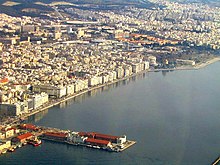User:Sarah fides/sandbox 2
Cityscape[edit]

-
City center: Church of Saint Gregory Palamas (Ernst Ziller)
-
Ano Poli (Upper Town):Typical architecture of the district
-
Southeast: Thessaloniki Concert Hall (building A)
Architecture[edit]

UNESCO World Heritage Sites[edit]

Due to Thessaloniki's importance during the early Christian and Byzantine periods, the city is host to several paleochristian monuments that have significantly contributed to the development of Byzantine art and architecture throughout the Byzantine Empire as well as Serbia.[1] The evolution of Imperial Byzantine architecture and the prosperity of Thessaloniki go hand in hand, especially during the first years of the Empire,[1] when the city continued to flourish. It was at that time that the Complex of Roman emperor Galerius was built, as well as the first church of Hagios Demetrios.[1]
By the 8th century, the city had become an important administrative center of the Byzantine Empire, and handled much of the Empire's Balkan affairs.[2] During that time, the city saw the creation of more notable Christian churches that are now UNESCO World Heritage Sites, such as Hagia Sophia of Thessaloniki, the Rotunda of Saint George, the Church of the Acheiropoietos, the Church of Panagia Chalkeon.[1] When the Ottoman Empire took control of Thessaloniki in 1430, most of the city's churches were converted into mosques,[1] but have survived to this day. Travelers such as Paul Lucas and Abdul Mecid[disambiguation needed][1] document the city's wealth in Christian monuments during the years of the Ottoman control of the city.
The church of Hagios Demetrios was burnt down during the Great Thessaloniki Fire of 1917, as did many other of the city's monuments, but it was rebuilt. During the Second World War, the city was extensively bombed and as such many of Thessaloniki's paleochristian and Byzantine monuments were heavily damaged.[2] Some of the sites were not restored until the 1980s. Thessaloniki has more UNESCO World Heritage Sites listed than any other city in Greece, a total of 15 monuments.[1] They have been listed since 1988.[1]
Thessaloniki 2012[edit]

In regards to the 100th anniversary of the incorporation of Thessaloniki into Greece, during 1912, the government announced a large-scale redevelopment program for the city of Thessaloniki, which aims in addressing the current environmental and spatial problems[3] that the city faces. More specifically, the program will drastically change the physiognomy of the city[3] by relocating the Thessaloniki International Exhibition Center and grounds of the Thessaloniki International Trade Fair outside the city centre and turning the current location into a large metropolitan park,[4] redeveloping the coastal front of the city,[4] relocating the city's numerous military camps and using the grounds and facilities to create large parklands and cultural centers;[4] and the complete redevelopment of the harbor and the Lachanokipoi and Dendropotamos districts (behind and near the Port of Thessaloniki) into a commercial business district,[4] with possible highrise developments.[5]
The plan also envisions the creation of new wide avenues in the outskirts of the city[4] and the creation of pedestrian-only zones in the city center.[4] Furthermore, the program includes plans to expand the jurisdiction of Seich Sou Forest National Park[3] and the improvement of accessibility to and from the Old Town.[3] The ministry has said that the project will take an estimated 15 years to be completed, in 2025.[4]
Part of the plan has been implemented with the revitalization of half the eastern urban waterfront/promenade, Nea Paralia (Greek: Νέα Παραλία, literally new beach), with a modern and vibrant design. The municipality of Thessaloniki's budget for the reconstruction of important areas of the city and most notably the rest of the waterfront, is estimated to be around €28.2 million (US$39.9 million) for the year 2011 alone.[6]
As of August 2011 work on the rest of the plan for the revilatization of the waterfront has began, stretching from the Thessaloniki yacht club to the White Tower.[7] It is estimated that the new parks will be completed within the next two years at a total cost of over 20 million euro.[7] Once complete, the entire city's Nea Paralia (waterfront) will feature a total of 12 thematic gardens/parks and an uninterrupted promenade, spanning for 3 km (2 mi) along the coast.[7][8]
References[edit]
- ^ a b c d e f g h Cite error: The named reference
UNESCOwas invoked but never defined (see the help page). - ^ a b Aristotle University of Thessaloniki, "The City of Thessaloniki" (in Greek)
- ^ a b c d Hellenic Government – Thessaloniki 2012 Program (in Greek)
- ^ a b c d e f g Ministry of the Environment, of Energy and of Climate Change – Complete presentation (in Greek)
- ^ "Σε επιχειρηματικό πάρκο μεταμορφώνονται οι Λαχανόκηποι ("Laxanokipoi is transformed into business district")". VORIA.gr. 26 February 2010. Retrieved 8 August 2011.
- ^ "Στα 28 εκατ. ευρώ το τεχνικό πρόγραμμα του δήμου". Makedonia (in Greek). Thessaloniki. 23 March 2011. Retrieved 25 March 2011.
- ^ a b c "Θεσσαλονίκη: Απέραντο εργοτάξιο η Νέα Παραλία". Agelioforos (in Greek). Thessaloniki. 15 September 2011. Retrieved 15 September 2011.
{{cite news}}: Unknown parameter|trans_title=ignored (|trans-title=suggested) (help) - ^ "Ανάπλαση της Νέας Παραλίας Θεσσαλονίκης – Νικηφορίδης / Cuomo". Nikiforidis-cuomo.com. Retrieved 2012-03-11.




